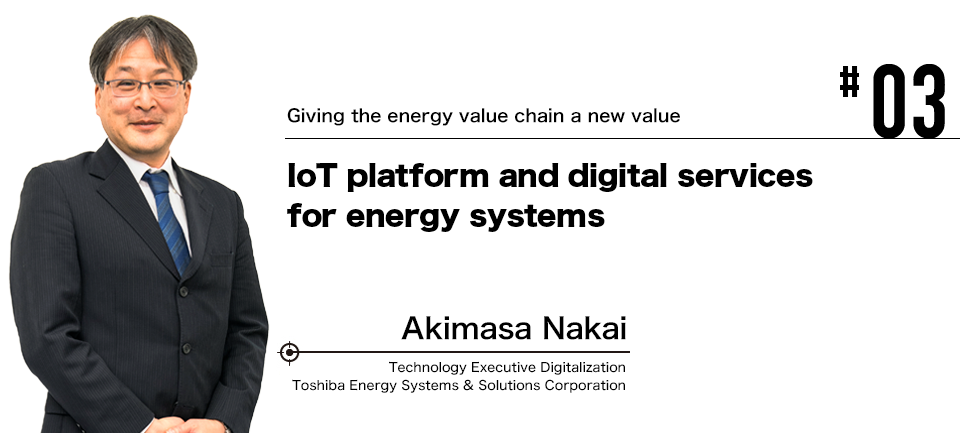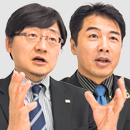To realize Cyber-Physical Systems (CPS), the knowledge in physical area for effectively utilizing the collected data is necessary in addition to assembly of advanced digital technologies. Toshiba Energy Systems & Solutions Corporation has delivered various products and systems to energy industries such as electric power plants. We aim to become a company that "designs the future of energy". We have a vision to create new business models that make use of the most of our engineering know-how accumulated and polished over many years of business experience. We developed "IoT platform for energy systems" as a common base to services complying with "Toshiba IoT Reference Architecture" and released the digital service that supports all phases of energy value chain; "producing", "transmitting", "storing", and "making efficient use" of energy based on it. This article introduces the background of development of "IoT platform for energy systems" and its outline, and the services utilizing this platform.
Challenging to the creation of a new energy business with CPS
A big structural change is required for the existing energy business against a background of rapid change of market such as reform of electric power system typified by tightening environmental regulation and unbundle in addition to dissemination of renewable energy. A keyword of new trend is "five D [1]". How we can build a business model responding to "De-population", "Deregulation", "De-carbonization", "Decentralization", and "Digitalization" is a common issue for various players who assume the charge of market.
Toshiba Energy Systems & Solutions Corporation thinks of this change as a business opportunity and promotes the activity for creating a new value early on. "We turn on the promise of a new day by designing the future of energy." Based on the vision shown above, we have promoted the development of proposition type service for entire energy value chain; "producing", transmitting", "storing", and " making efficient use" of energy starting from the issues of customers in addition to creation of system or service.
Cyber-Physical Systems (CPS) play an important role in realizing our vision. Electric power facility and equipment we provide have an enormous quantity of data related to design and manufacturing and operation of these equipment at the field generates various operation data and field data. These data are analyzed in cyber space by combining with customer's maintenance history and public data. CPS that feeds back the results to the field is a necessary system for providing a new value for customers in neighboring market such as retail electricity suppliers, power transmission and distribution business operators, renewable energy developers, and aggregators in addition to existing customers such as electric power companies.
We will keep challenging to create the next-generation energy business with fusion of engineering technologies polished at the field and advanced digital technologies. The activities for CPS we have been expected has started in entire TOSHIBA and "Toshiba IoT Reference Architecture (hereafter, TIRA)" has been formulated.
Click here to move to the top of this page.
Common base to services "IoT platform for energy systems"
TIRA that is open and common framework to develop and operate IoT service realizing CPS has sufficiently met the conditions to create a new energy business.
For CPS, the viewpoint of control is necessary when taking an action from cyber space (virtual space) to physical space (real world). In the energy industry, for example, the analysis of design concept of electric power facility and equipment, maintenance history, and current situation without fixed knowledge and know-how based on experiences cannot elicit what is the optimum action in the real world even if how many data is collected and analyzed. By complying with TIRA defined the architecture involving both of control and service, it is possible to rotate cyber and physical cycles well while freely utilizing the actual achievement that has been accumulated for a long time (Fig.1).
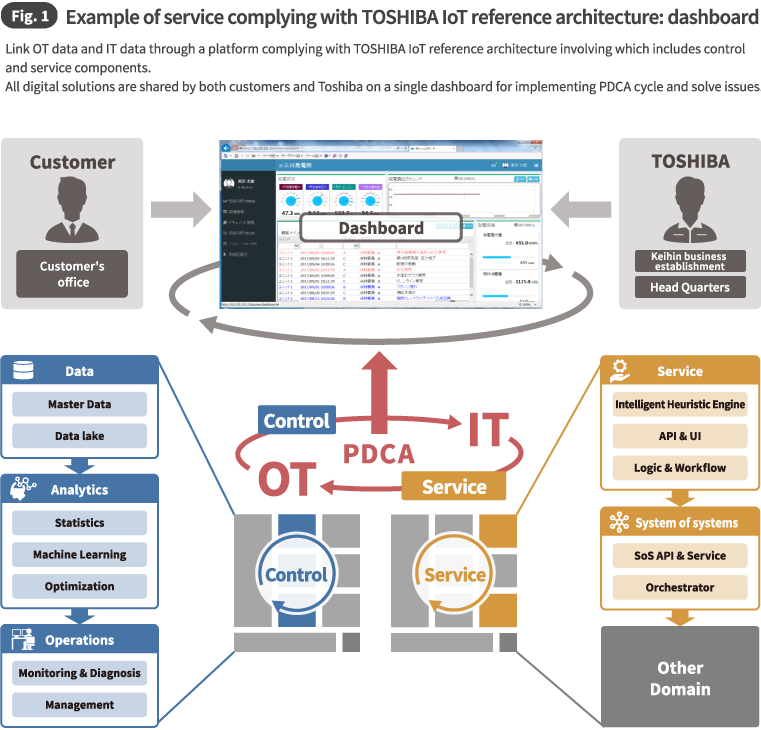
Moreover, the fact that the response to System of Systems is clearly defined by open API* is also the big appeal. When a service is developed for entire value chain of energy, the open cooperation with domestic and foreign partners is necessary. It is possible to come close to the realization of our vision aiming at the provision of additional value during all phases such as "produce", "transmit", "store", "make efficient use" by utilizing this architecture which can freely connect external systems and applications and can infinitely expand the circle of co-creation.
* API: Application Programming Interface
First, Toshiba Energy Systems has constructed "IoT platform for energy systems" complying with TIRA. We consolidated the common base for developing a service by merging manufacturing / maintenance technologies and CPS technology in energy field which have been cultivated and jumping the barriers of power generation, energy transmission and distribution, and adjustment of demand and supply of electricity etc.
After realizing various common functions which are enabled by compliance with TIRA such as micro service that supports flexible response to customer's needs and easy expansion, hybrid configuration that can diverge various data and functions into cloud and on-premises in an optimal way, distributed database that supports seamless provision of services while utilizing the existing systems, and access to data with information model special to our company that has immense knowledge related to phenomenon and behaviors, we started to implement concrete services.
The services we released for the first series are; "dashboard", "real-time plant efficiency monitoring", "failure prediction", "design and maintenance data linkage between documents", and "optimal power generation planning".
Click here to move to the top of this page.
IoT service responding to issues in the energy industry
The mentioned services provide the solution with actual achievement of gathering our company's know-how at "integration level" such as energy demand forecasting and optimum operation of multiple electric power plants and at "plant level" such as failure prediction and improvement of plant availability as user-friendly and high-quality IoT service (Fig.2).
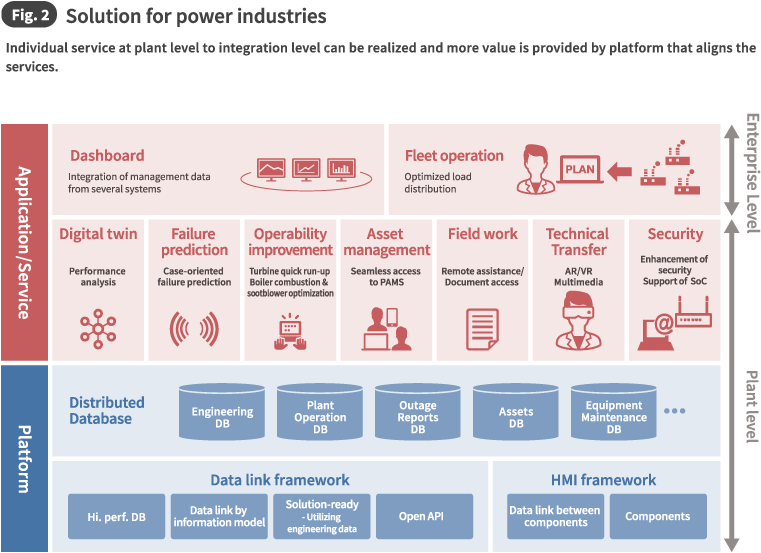
These services certified as lineup of TOSHIBA SPINEX respond to three issues in energy industry shown below and aim at the resolution.
* The certification of TOSHIBA SPINEX is explained in #02.
The first issue is the response to increasing power generation amount of renewable energy. The optimum energy mix is realized by combining power supplies with different characteristics such as thermal power, hydraulic power, solar power, wind power in a balanced manner to respond to the optimization of entire energy value chain. To utilize the renewable energy at maximum, it is necessary to forecast the power generation amount of renewable energy that considerably varies depending on electric energy to be used by consumers and climate conditions to operate the thermal electric power plant etc. properly. After forecasting needed thermal power, "optimal power generation planning" service makes a power generation plan of individual electric power plant efficiency in order to minimize fuel cost.
These services support timely and high-accuracy decision-making for power generation plan and decision-making utilizing "forecasting + optimization" in various fields giving consideration to increase or decrease of electric power demand, internal situation of electric power plan, and power generation costs such as fuel price and considerably contribute to the improvement of economic efficiency and profitability of energy business due to optimization of total value chain.
The second issue is response to improvement of plant availability and reduction of maintenance cost. Here, we widely apply the digital modernization that regenerates the existing equipment with digital technology by "real-time plant efficiency monitoring", "failure prediction", "design and maintenance data linkage between documents", and services of "dashboard".
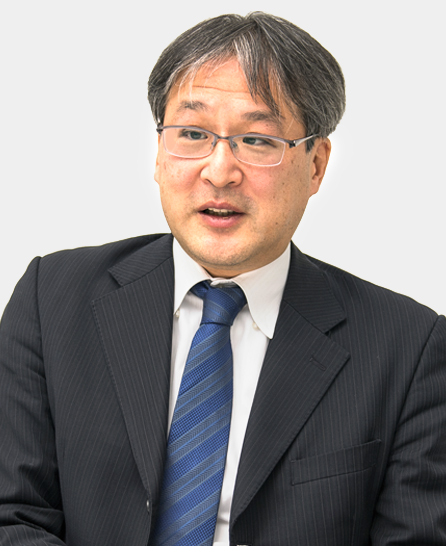
With the "real-time plant efficiency monitoring", a defect is found by building the thermal efficiency model of plant and monitoring the performance while always analyzing the operation data such as temperature, pressure, and amount of steam in electric power plant. The timely maintenance improves the cost efficiency and supports the optimum decision-making related to repair or replacement of physical facility. With the "failure prediction", the abnormality symptom of main parts is detected using the digital technology. It enables taking measures before a potential performance problem is exposed by preventing long downtime avoiding a serious failure, for example. And with the "design and maintenance data linkage between documents", the engineering data such as drawings and technical documents of electric power plant are collectively managed. It dramatically streamlines the operation using drawings by easily comprehending the performance of equipment while aligning the information of various drawings, for example. The dashboard cooperating with these services to display the content according to each objectives of users can support efficient responses to issues.
The third issue is the response to optimum operation of energy at small and medium-size cogeneration plant*. The proper operation of entire plant for which extension or reconstruction have been repeatedly implemented and the optimum generation of electric power and steam are required. Consequently, the change of heat rate of turbines and boilers is analyzed based on the actual operation data. The optimization of operation can be realized by investigating the deteriorated equipment and supporting the re-design of heat balance.
* Cogeneration plant: the plant that generates thermal energy supplied to a factory such as steam and electric power at the same time. This plant cannot be operated easily compared with a simple power-generating plant.
The engineering power which has been cultivated in such a field cannot be obtained in a short space of time. Delivering the IoT service freely utilizing this superiority to all customers related to energy is a new mission of Toshiba Energy Systems and Solutions Corporation.
User-friendly and high-quality IoT service will be improved in series while focusing on security and measures for BCP*. We will respond to customers and support the society as a company that resolves various issues in energy field and designs the future of energy aiming at innovation of energy value chain and creation of new value.
*BCP: Business Continuity Plan
Reference literature:
[1] Junko TAKEUCHI and others (2017) "Game change of
energy industry toward Utility3.0 in 2050" Nikkei Publishing Inc.
* The corporate names, organization names, job titles and other names and titles appearing in this article are those as of February 2020.





